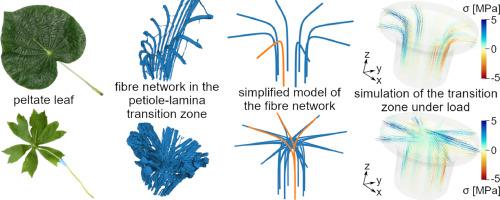盾形叶叶柄-叶片过渡区的力学模型。
IF 9.4
1区 医学
Q1 ENGINEERING, BIOMEDICAL
引用次数: 0
摘要
植物叶片必须应对各种环境影响。虽然人们对叶柄和叶片的机械特性进行了深入研究,但只有少数研究关注连接叶柄和叶片的过渡区的特性。特别是盾形叶片,其特点是叶柄附着在叶片背面,三维叶片结构对叶柄和叶柄-叶片过渡区施加了特定的机械应力。已经确定了内部解剖组织的几项原则。由于难以通过直接测量来确定过渡区的机械特性,我们通过有限元模拟来探索其机械特性和承载机制。我们用从 CT 数据中抽象出的五种不同纤维模型模拟叶柄-叶片过渡区。为了进行比较,我们定义了三种不同的负载情况,并在模拟中进行了测试。在所提出的模型中,纤维以涂抹方式表示,我们考虑了包含纤维的元素的横向各向同性行为。在预处理步骤中,我们确定了纤维的含量、方向和分散性,并将其输入模型。模拟结果表明,最初,基体和纤维共同承受载荷。基体中的应力松弛后,纤维承担大部分载荷。载荷耗散和刚度因纤维排列而异,并取决于纤维的取向和交联以及纤维量等因素。尽管所介绍的方法只是一种简化方法,但它能够显示出所介绍的纤维排列的不同承载能力。意义说明:在植物叶片中,叶柄-叶片过渡区是一个重要的结构元素,可促进水分和养分的运输,并将负荷从叶片分散到叶柄中。特别是在盾形叶片中,三维叶片结构对叶柄-叶片过渡区施加了特定的机械应力。本研究旨在利用有限元模拟研究其机械行为。所提出的连续机械各向异性粘弹性材料模型能够模拟不同载荷下的过渡区,同时还考虑了不同的纤维排列。模拟结果凸显了不同纤维组织的承重机制,显示了叶柄-叶片过渡区的力学意义,可用于未来建筑中仿生接合点的设计。本文章由计算机程序翻译,如有差异,请以英文原文为准。

Mechanical modeling of the petiole-lamina transition zone of peltate leaves
Plant leaves have to deal with various environmental influences. While the mechanical properties of petiole and lamina are generally well studied, only few studies focused on the properties of the transition zone joining petiole and lamina. Especially in peltate leaves, characterised by the attachment of the petiole to the abaxial side of the lamina, the 3D leaf architecture imposes specific mechanical stresses on the petiole and petiole-lamina transition zone. Several principles of internal anatomical organisation have been identified. Since the mechanical characterisation of the transition zone by direct measurements is difficult, we explored the mechanical properties and load-bearing mechanisms by finite-element simulations. We simulate the petiole-lamina transition zone with five different fibre models that were abstracted from CT data. For comparison, three different load cases were defined and tested in the simulation. In the proposed model, the fibres are represented in a smeared sense, where we considered transverse isotropic behavior in elements containing fibres. In a pre-processing step, we determined the fibre content, direction, and dispersion and fed them into our model. The simulations show that initially, matrix and fibres carry the load together. After relaxation of the stresses in the matrix, the fibres carry most of the load. Load dissipation and stiffness differ according to fibre arrangement and depend, among other things, on orientation and cross-linking of the fibres and fibre amount. Even though the presented method is a simplified approach, it is able to show the different load-bearing capacities of the presented fibre arrangements.
Statement of significance
In plant leaves, the petiole-lamina transition zone is an important structural element facilitating water and nutrient transport, as well as load dissipation from the lamina into the petiole. Especially in peltate leaves, the 3D leaf architecture imposes specific mechanical stresses on the petiole-lamina transition zone. This study aims at investigating its mechanical behavior using finite-element simulations. The proposed continuum mechanical anisotropic viscoelastic material model is able to simulate the transition zone under different loads while also considering different fibre arrangements. The simulations highlight the load-bearing mechanisms of different fibre organisations, show the mechanical significance of the petiole-lamina transition zone and can be used in the design of a future biomimetic junction in construction.
求助全文
通过发布文献求助,成功后即可免费获取论文全文。
去求助
来源期刊

Acta Biomaterialia
工程技术-材料科学:生物材料
CiteScore
16.80
自引率
3.10%
发文量
776
审稿时长
30 days
期刊介绍:
Acta Biomaterialia is a monthly peer-reviewed scientific journal published by Elsevier. The journal was established in January 2005. The editor-in-chief is W.R. Wagner (University of Pittsburgh). The journal covers research in biomaterials science, including the interrelationship of biomaterial structure and function from macroscale to nanoscale. Topical coverage includes biomedical and biocompatible materials.
 求助内容:
求助内容: 应助结果提醒方式:
应助结果提醒方式:


